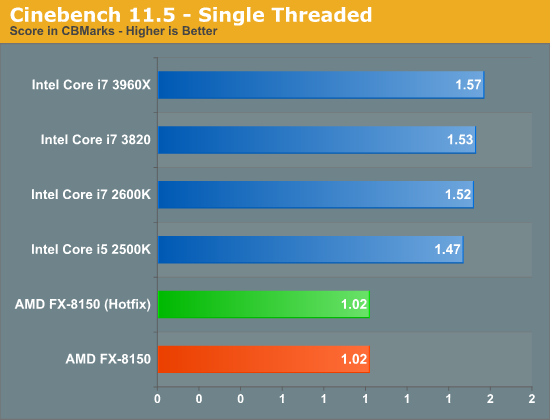The AMD FX (Bulldozer) Scheduling Hotfixes Tested
by Anand Lal Shimpi on January 27, 2012 12:47 PM ESTSingle & Heavily Threaded Workloads Need Not Apply
Remembering what these two hotfixes actually do, the only hope for performance gains comes from running workloads that are neither single threaded nor heavily threaded. To confirm that there are no gains at either end of the spectrum we first turn to Cinebench, a 3D rendering test that lets us configure how many threads are in use:


With one thread or 8 threads active, the FX-8150's performance is unchanged by the new hotfixes. I also ran TrueCrypt's encryption/decryption benchmark, another heavily threaded test that runs on all cores/modules:

Once again, there's no change in performance. Although you can argue that CPU performance is most important when utilization is at its highest, most desktops will find themselves in between full utilization of a single core and all cores. To test those cases, we need to look elsewhere.










79 Comments
View All Comments
Ratman6161 - Saturday, January 28, 2012 - link
With an Intel i3 2100. I suspect the gamers might actually be better served with the i3 than AMD's 8150 other than the inability to overclock the i3. Think of how much better a GPU you could get by saving about $150 by going with an i3 over an 8150.Just sayin...
medi01 - Sunday, January 29, 2012 - link
Did you forget something important?Taking into account, cough, motherboard prices, cough?
The "you can get much better GPU for XX bucks" stands for pretty much any non low end CPU.
xeridea - Monday, January 30, 2012 - link
AMD did a blind test with the 2700k and 8150. 28% chose 2700k, 51% chose 8150, 20% undecided. It is a possibly an anomaly that the 8150 got more votes, but it at least shows that it is competitive as a gaming CPU, even compared to the 2700k which costs $100 more.IIRC the 8150 is competitive and sometimes beats the 2500k and even beats the 2600k in some highly threaded situations.
Your figures are wrong. Intel has the 2600k for $325 and the 8150 for $270. This means the 8150 is $65 less than the 2600k, not $30. It is $40 more than the 2500k but you have to consider generally higher cost of motherboard/memory with Intel, and guaranteed socket incompatibility with every CPU.
arjuna1 - Saturday, January 28, 2012 - link
Yeah, Imagine how pathetic can a life be when you need to sustain your ego by hating the competing brand of your PC's cpu.Fox5 - Saturday, January 28, 2012 - link
Wasn't the point of the hotfix to consolidate threads onto modules, so that modules could be gated and turbo core enabled? Isn't that where the performance boost is supposed to come from?KonradK - Sunday, January 29, 2012 - link
Windows 7 sheduler since beginning tries to group many threads on single core. It is mainly for maximize effect of power gates. I'm not sure whether core must be completely idle for turbo core/turbo boost to be enabled.Purpose of hotfix was to make sheduler distingushing between cores beloging to the same, or separate module.
Mech-Akuma - Monday, January 30, 2012 - link
This is what I thought as well. I remember reading somewhere when Bulldozer launched that Win7 prefers to primarily direct all threads to cores inside different modules. This would cause modules not to be able to enter C6 sleep and therefore the performance improvement of Turbo Core would be drastically cut. However since each module does not need to share resources (while each module is only using 1 core) performance is picked up there.However this contradicts what this article says about pre-hotfix scheduling. Could someone clarify how pre-hotfix scheduling worked?
silverblue - Saturday, January 28, 2012 - link
Toms did the same thing. However, I'm not sure it'd make much difference.richaron - Monday, January 30, 2012 - link
As far as I'm aware 1600 is the most developed ram at the moment. I consider anything faster as simply overclocked 1600; more "bandwidth", more voltage, but lower cas latency.I'm not sure what the reviewers were thinking, but they probly know more than most of us...
KonradK - Saturday, January 28, 2012 - link
"No. Bulldozer adds silicon that actually executes instructions. [...]"Whole idea of Hyperthreading is to let a second thread utilize resources of core wasted by first thread (and vice-versa).
Depending on fact how much the execution units are replicated and how (un)optimally written is code amount of wastes (and benefits from Hyperthreiding) will be lower or greater.
Maybe the execution units of Bulldozer's FPU are replicated to the such excent that it will be wasted in most cases unless used by two threads simultaneusly.
But performance of two (FPU intensive) threads running on the same module will never be equal to the performance of two threads running on separate modules.*
Otherwise hotfixes to sheduler would be useless.
*) Assuming that CPU is not fully loaded i.e. some cores remains idle.